
Photo illustration: Twitter Ads vs Google Ads
Twitter Ads offer targeted audience engagement through real-time conversations and trending topics, while Google Ads provide extensive reach via search intent and diverse display networks. Discover the strengths and best use cases of both platforms in this article.
Table of Comparison
| Feature | Twitter Ads (X Ads) | Google Ads |
|---|---|---|
| Platform Reach | Active Twitter users globally, focused on real-time conversation trends | Google Search Network, YouTube, Display Network - largest global reach |
| Ad Formats | Promoted Tweets, Promoted Trends, Video Ads, Carousel Ads | Search Ads, Display Ads, Video Ads, Shopping Ads |
| Targeting Options | Keywords, Interests, Follower Look-alikes, Location, Device | Keywords, Demographics, Interests, Remarketing, Location |
| Cost Model | CPC, CPM, CPV focused on engagements and impressions | CPC, CPM, CPA, CPV with flexible bidding strategies |
| Advertising Goal | Brand awareness, engagement, conversation amplification | Lead generation, sales conversions, app installs, website traffic |
| Analytics & Reporting | In-depth Twitter Analytics, engagement metrics, trend analysis | Google Analytics integration, conversion tracking, performance reports |
| Ideal For | Brands targeting real-time conversations and trending topics | Businesses needing extensive keyword targeting and diverse ad placements |
Overview of Twitter Ads, Google Ads, and Ad Campaigns
Twitter Ads offers targeted promotion through tweets, leveraging user interests, demographics, and behavior to maximize engagement and brand visibility. Google Ads enables businesses to appear in search results and across the Display Network, using keywords and bidding strategies to drive qualified traffic to your website. Optimizing your ad campaigns on these platforms requires continuous analysis of performance metrics like click-through rates, conversion rates, and cost-per-acquisition to ensure efficient allocation of your advertising budget.
Key Differences Between Twitter Ads and Google Ads
Twitter Ads primarily target users based on real-time conversations, interests, and follower profiles, making them ideal for brand awareness and engagement campaigns. Google Ads utilize keyword targeting and intent-based searches, delivering ads when users actively seek specific products or services, optimizing for conversions and direct sales. Campaign performance metrics differ as Twitter emphasizes engagement rates and impressions, whereas Google focuses on click-through rates (CTR) and conversion tracking for ROI measurement.
Target Audience Capabilities: Twitter Ads vs Google Ads
Twitter Ads excel in targeting real-time conversations and niche interests, allowing your campaigns to reach highly engaged users based on hashtags, follower behaviors, and trending topics. Google Ads offers advanced intent-based targeting through search queries, demographics, and detailed audience segments, enabling precise reach of users actively seeking specific products or services. Understanding your target audience capabilities on these platforms ensures efficient allocation of your budget to maximize engagement and conversion rates.
Ad Formats and Creative Options Comparison
Social media platforms offer a wide range of ad formats including image ads, video ads, carousel ads, and story ads, each tailored to different marketing objectives and audience engagement levels. Platforms like Facebook and Instagram provide extensive creative options such as interactive polls, shoppable posts, and augmented reality filters, enhancing user interaction and brand storytelling. TikTok emphasizes short-form video content with dynamic editing tools, while LinkedIn focuses on professional targeting through sponsored content and InMail ads for B2B campaigns.
Cost and Bidding Structure Explained
Social media advertising costs vary widely depending on the platform, targeting options, and campaign goals, with budgets often controlled through bidding structures such as cost-per-click (CPC) or cost-per-impression (CPM). You can optimize your ad spend by understanding bidding strategies like manual bidding, where you set maximum bids, or automated bidding, which lets algorithms adjust bids to achieve desired outcomes. Platforms like Facebook, Instagram, and LinkedIn each use distinct auction models that influence how costs are calculated and how effectively your budget converts into engagement or sales.
Performance Metrics and Analytics Tools
Performance metrics such as engagement rate, click-through rate, and conversion rate provide critical insights into your social media effectiveness. Analytics tools like Google Analytics, Hootsuite, and Sprout Social help track audience behavior, campaign performance, and content reach in real-time. Leveraging these data-driven tools empowers you to refine strategies and achieve measurable growth across social platforms.
Industry Suitability: Which Platform Works Best?
Choosing the right social media platform depends on your industry's target audience and content type. Visual-centric platforms like Instagram and Pinterest excel for fashion, food, and lifestyle brands, while LinkedIn is ideal for B2B services and professional networking. Understanding which platform aligns with your industry ensures maximum engagement and effective marketing outcomes.
Pros and Cons of Twitter Ads
Twitter Ads offer precise targeting options, allowing you to reach specific demographics and interests, which can boost brand visibility and engagement effectively. However, the platform's fast-paced environment means Ads can quickly get lost in the feed, leading to lower organic reach and potential audience fatigue. Managing your budget carefully is essential to maximize ROI, as costs can escalate without guaranteed sustained conversions.
Pros and Cons of Google Ads
Google Ads offers precise targeting options that help you reach a highly specific audience, increasing the chances of converting clicks into customers. However, the platform can become costly if campaigns are not carefully managed, leading to inefficient ad spend and lower return on investment. Balancing budget control with optimized ad strategies is essential to maximize the benefits of Google Ads for your social media marketing efforts.
Choosing the Right Ad Campaign Platform for Your Goals
Selecting the ideal social media ad platform depends heavily on clearly defined campaign goals such as brand awareness, lead generation, or direct sales. Facebook Ads excel in detailed audience targeting and broad reach, while LinkedIn Ads provide superior B2B engagement for professional services. Instagram and TikTok are optimal for visually-driven campaigns targeting younger demographics and influencer collaborations to maximize engagement and conversion rates.
 socmedb.com
socmedb.com